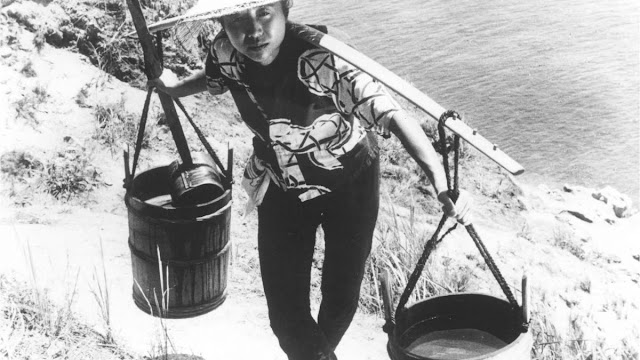CCC FAQ #5 : When did Contemplative Cinema actually begin?
Contemporary Contemplative Cinema Frequently Asked Questions #5 :
When did Contemplative Cinema actually begin?
A commercial feature film (not an experimental short film), with rare spoken words and a thin plot, moreover in black & white. It recounts the tough life of one family of four whose raison d’être is to grow and care for their crops atop a barren island without any water spring. Every day the family rows a canoe to the nearest land proving fresh water and meticulously brings back a few pots full of the precious liquid, to scrupulously douse their plants. The takes are longer in duration. The story is mundane (with one single incident).
Halfway through the 130 odd years history of cinema, this unprecedented surprise gained financial success amongst the general audience in Japan and in the world, it also garnered critical acclaim as it won several festival awards (in the Soviet Union, Spain and Italy). Meanwhile, the New Waves (in Japan, France, Italy…) raged on, and the Modernist films were popular.
Instead of opening the path for a streak of similar prototypes, in the mainstream audience, this novel aesthetic form went underground, straight to the experimental niche. In 1964, Andy Warhol (USA) took it to its most unbearable extremity, with a 9h long static shot of the Empire Building ! It’s the first Frederick Wiseman documentary in 1967, with Titticut Follies (USA), and in 1971, another underestimated landmark is Deligny’s Le moindre geste (France). Three feature films by Sohrab Shahid Saless (Iran), A Simple Event (1973), Still Life (1974) and Far From Home (1975).
The most famous milestone of all yet, (incidentally « The Greatest Film Of All Time » according to Sight & Sound’s 2022 poll !) created by a young Chantal Akerman, will be forever known as Jeanne Dielman, 23 quai du commerce, 1080 Bruxelles, in 1975.
Only a couple of Contemplative films every year until 1997 (lest not forget Béla Tarr’s Satantango in 1994), when the movement took off with 10 or a dozen new Contemplative films every year… and the rest is history. This is how Contemporary Contemplative Cinema started, a slow-burn beginning, under the radar, peppered with giant landmarks that have influenced film festivals and filmmakers to give birth to the Contemplative Cinema of the 2000's, one generation later. But we can't discount these odd prototypes and older landmarks because they do belong formally to this aesthetics as a whole (distinct from Modernist precursors, mainly by their singular muted voice).
 |
| Kaneto SHINDO's The Naked Island (1960) |
Read also at Unspoken Cinema:
Comments